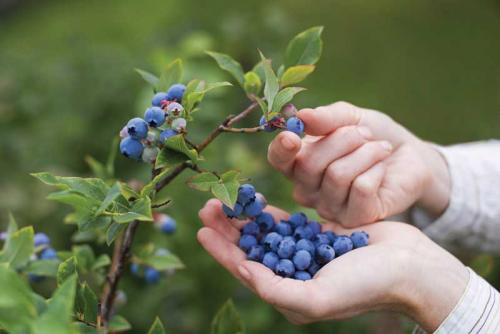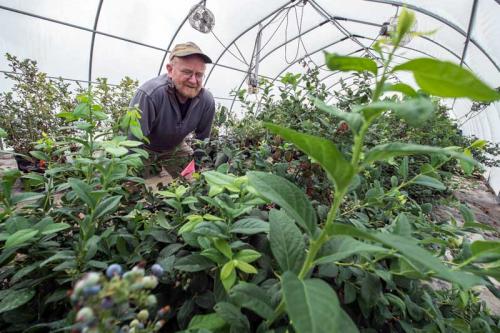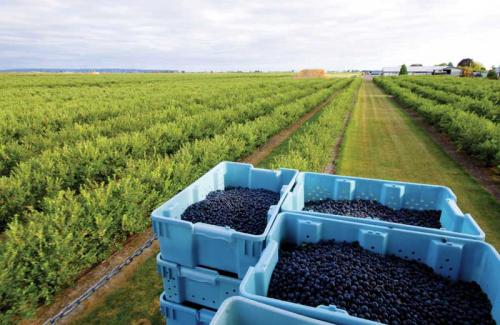Building a better blueberry: A Spartan breeder perfects one of Michigan's finest fruits
A Spartan plant breeder perfects one of Michigan's finest fruits for global consumption. As James Hancock nears retirement, he leaves an indelible mark on the blueberry business near and far.

Blueberries enjoy worldwide popularity, thanks to their sweetness and antioxidant-rich nutrition profile. But the bounty of nature alone is not enough to keep pace with the heavy demand for this tasty, healthy fruit. Success depends on the introduction of new cultivars to meet the changing needs of consumers as well as growers. And for more than half a century, Michigan State University (MSU) has been a key player in bringing new blueberry varieties to the table.
Since the early 1900s, blueberries have been commercially grown in Michigan, and today the tiny berries are big business. In 2011, the Michigan blueberry industry spanned 18,000 acres and yielded 72 million pounds of fruit valued at more than $118 million.
Breeding abundance
 In the 1960s, MSU horticulturist Stanley Johnston, perhaps best known for developing the Red Haven peach, created both the Northland and Bluehaven blueberry varieties. But few MSU plant breeders have been more successful than MSU AgBioResearch scientist James Hancock. A professor of horticulture and recipient of the 2014 MSU Innovation Center Technology Transfer Achievement Award for excellence in applying innovation to create real-world solutions, Hancock developed four of the world’s most widely planted northern highbush blueberry varieties: Aurora, Draper, Huron and Liberty (20 million plants of these varieties have been sold), along with several other successful cultivars during the past three decades at MSU.
In the 1960s, MSU horticulturist Stanley Johnston, perhaps best known for developing the Red Haven peach, created both the Northland and Bluehaven blueberry varieties. But few MSU plant breeders have been more successful than MSU AgBioResearch scientist James Hancock. A professor of horticulture and recipient of the 2014 MSU Innovation Center Technology Transfer Achievement Award for excellence in applying innovation to create real-world solutions, Hancock developed four of the world’s most widely planted northern highbush blueberry varieties: Aurora, Draper, Huron and Liberty (20 million plants of these varieties have been sold), along with several other successful cultivars during the past three decades at MSU.
“Dr. Hancock’s legacy of blueberry breeding has increased access to healthy, antioxidant-rich fruit for families around the world,” said Rich Chylla, executive director of MSU Technologies. “Pairing that with the multimillion dollar impact it’s made for growers across Michigan and internationally, the strength of his research program has created a win-win for everyone involved.”
Ed Wheeler, a blueberry breeder for MBG Marketing, a Michigan-based marketing cooperative organization for blueberry growers, concurs that Hancock’s varieties have benefited the industry from Michigan to the Pacific Northwest and as far away as Chile, parts of Europe and South Korea.
“He has set the bar for blueberry breeding,” Wheeler said. “His varieties have done very well here, and they’ve started to go all over the world and change the types of blueberries that people grow.”
Larry Bodtke, a blueberry grower whose berries grown in Michigan and Oregon are primarily sold under the Naturipe Farms brand, said Hancock’s varieties have played a significant role in expanding the blueberry industry in the Pacific Northwest.
 “His varieties do very well in Washington and Oregon, where the milder winter climate really helps them grow,” Bodtke said. “A lot of the blueberries planted there are from Dr. Hancock’s varieties.”
“His varieties do very well in Washington and Oregon, where the milder winter climate really helps them grow,” Bodtke said. “A lot of the blueberries planted there are from Dr. Hancock’s varieties.”
The breeding work is revered not only in the blueberry industry but among his academic colleagues as well. MSU AgBioResearch potato breeder David Douches is the director of the MSU plant breeding, genetics and biotechnology graduate program.
“Jim Hancock is just an excellent example of the impact plant breeding can have,” Douches said. “He diligently worked for decades, and what emerged are transformative varieties that created change within the industry and in what we eat.”
A growing evolution
 Hancock began working at MSU in 1979. He used his experience in evolutionary genetics to study blueberries and several other small fruits in an effort to identify traits beneficial for commercial production. Ideal blueberry candidates not only have superior taste but are adaptable to environmental stresses and pressure from diseases and insects.
Hancock began working at MSU in 1979. He used his experience in evolutionary genetics to study blueberries and several other small fruits in an effort to identify traits beneficial for commercial production. Ideal blueberry candidates not only have superior taste but are adaptable to environmental stresses and pressure from diseases and insects.
Working closely with U.S. Department of Agriculture blueberry breeder Arlen Draper, in honor of whom Hancock named the Draper variety, Hancock realized the need for new varieties in Michigan. In 1979, Michigan farmers were planting 30- to 60-year-old varieties such as Bluecrop, which thrives in midseason but left sizable gaps at both the beginning and the end of the growing season.
Growers experience their highest profits from early and late harvest, when supplies are lowest. Late-season fruit needs to tolerate the highly fluctuating temperatures of fall. Hancock’s Aurora and Liberty varieties have a harvest that begins after older late-season varieties such as Bluecrop.
Both varieties produce high and consistent yields during the late growing season and tolerate the harsh late-season temperatures.
Both Hancock and Draper had developed extensive germplasm resources — collections of wild and cultivated plants of all shapes, colors and sizes. Combining these sources enabled Hancock to identify the plants with the most desirable characteristics. Hancock’s germplasm bank consists of 121 plants. Eventually he started to crossbreed those plants and trial them at the then newly opened MSU Southwest Michigan Research and Extension Center (SWMREC) in Benton Harbor in the early 1990s.
“If you were to talk to the commodity groups, not just blueberries but almost every crop, new varieties would be one of their highest priorities in current needs,” Douches said.
After 14 years of trials, Hancock emerged with results that exceeded his expectations: six varieties of MSU blueberries that together span the entire growing season.
“As a breeder, I’m most proud of the varieties,” Hancock said. “We released three in 2004, and they’ve all done extremely well, and in the past five years we’ve released three more. I feel good having the whole production season covered, and I think we’ve delivered what Michigan growers needed.”
The timing was also right, Hancock admits. When he started the breeding process, Michigan was by far the leading blueberry state, and there was significant but not huge acreage in the Pacific Northwest and in Europe. The industry in Chile was just emerging and would later become a key player along with Europe and Asia.
“My varieties hit the blueberry wave at the industry’s absolute peak, and that wave is still going,” Hancock said. “Being a successful entrepreneur is not only being really smart and figuring out what’s needed but also being tremendously lucky and hitting that wave when it’s really rolling.”
The first step in the breeding process is to identify which parent plants possess the most desirable characteristics.
 Once that is determined, the breeder collects pollen from one parent plant by rolling the open flower between his/her fingers, causing the pollen to fall from the stamens onto a waiting microscope slide. The stigmas of the other parent are then touched to the pollen-laden slide.
Once that is determined, the breeder collects pollen from one parent plant by rolling the open flower between his/her fingers, causing the pollen to fall from the stamens onto a waiting microscope slide. The stigmas of the other parent are then touched to the pollen-laden slide.
This causes the plants to produce seeds containing a mix of both parents’ genetics. Playing matchmaker between sets of parent plants is one of Hancock’s favorite aspects of breeding.
“One of the most fun things about my work is thinking about which parents would give the most beneficial mix of traits, and then putting them together,” he said.
Though the hybridization process remains the driver of plant breeding, the tools that breeders use to pursue it are constantly advancing. All MSU plant breeders now integrate some aspect of emerging biotechnologies in their quest to produce improved crop varieties. This can involve anything from simple tissue cultures to more complex procedures, such as genetic engineering to insert or silence certain genes or using gene marker technology to gain a better understanding of the germplasm. For example, tissue cultures are an essential part of the early phase of Hancock’s blueberry program, when controlled, sterile laboratory conditions are required for determining how plant traits are developed.
“Our plant breeding faculty take the promise of basic scientific research and translate it into something that can benefit everyone in society, which in this case is new plant varieties,” Douches said. “That’s our responsibility. We’re not asking our basic scientists to become breeders; we’re working together with them to link the laboratory with the field.”
Many MSU plant breeders focus on crops that are economically important to Michigan. In addition to Hancock’s work with blueberries, breeding programs are also producing key new varieties of dry beans, wheat, soybeans, sugar beets, strawberries, tart cherries, cucurbits and the sugar substitute stevia. Douches has helped produce 15 varieties of potatoes since he began his research at MSU in 1988. Some faculty members are also beginning to explore the emerging field of biofuel crops.
“That’s a crosscutting of interesting crops, many of which have more complex genetics than the diploid crops that students are commonly trained in, such as corn,” Douches said. “Our students and researchers work on a broad mix of traditional and specialty crops, whereas if you were to go to a school in Indiana or Iowa, you’d be exposed to a more limited set. In that way, we consider ourselves an important school nationwide for training professional breeders that could end up in the public or private sector.”
Collaboration is a significant part of what makes the MSU plant breeding program so formidable in specialty crops such as blueberries. While collaboration between breeders and plant pathologists (scientists who study plant diseases caused by fungi, bacteria and other infectious organisms) is the most common, breeding efforts often extend far beyond that.
“We work with a range of scientists, from entomologists and nematologists to faculty in food science, agricultural engineering and genetics,” Douches explained. “These interactions have allowed us to broaden our work and adopt new technologies that expand our capabilities.”
The hybridized blueberry plants are grown in a greenhouse until they produce seeds. The seeds must be exposed to cool temperatures to encourage a period of dormancy to germinate properly. In nature, this is accomplished under the cover of damp leaves in autumn and snow in winter. To simulate these conditions, Hancock places the seeds in a standard freezer for two months. Then he thaws and sprouts them. When they are large enough, they are planted at the MSU research center in Benton Harbor, where they are closely observed and evaluated for four years.
“During the summer, I walk up and down the blueberry rows once a week to observe them at different times of the season, and I take notes on every plant,” Hancock said. “We need to identify the ones that are consistently great over the years. They need to be exceptional.”
A blueberry plant must meet a long list of qualifications for Hancock to deem it exceptional, including fruit flavor, color, firmness and size. The plant shape is also important to accommodate harvest techniques, whether mechanical or hand picking. Only about 1 percent of plants
make it past the first round of evaluation. Once selected, the exceptional plants are sent to growers worldwide for additional evaluation — typically four to six years — before release to the industry for production.
“All told, from the time we make the first cross between the two plants to releasing a new variety, it can take 10 to 15 years,” Hancock said. “A plant breeder has to be very patient, but it’s very satisfying to finally reach that point. It’s a rush.”
Hancock also relies on a skilled research team, including lab technician Peter Callow, who has been at his side since 1984.
“Pete is steady as a rock,” Hancock said. “He’s been totally dependable, and I’m very thankful for that. Almost all of the work, except field maintenance, is done by just the two of us.”
A lasting legacy
 Hancock is planning to retire in 2015, but there is little doubt that his contributions to the blueberry industry will be felt for years to come.
Hancock is planning to retire in 2015, but there is little doubt that his contributions to the blueberry industry will be felt for years to come.
“We’ve infused new blood into the blueberry industry with these new varieties,” Callow said. “His successor will inherit a nice germplasm and be able to hit the ground running.”
Despite valuable and lucrative contributions to the industry over his career, Hancock’s work is perhaps more importantly having an impact on everyday lives.
“Jim Hancock’s values are not in the royalties but in that he developed something successful that’s being used by people around the world,” Douches said. “The royalties are great for the school and for funding the future of blueberry research, but that’s not where his heart is. Breeders don’t get into the business for that — they get into it to create things that will help people.”
This sentiment is echoed by his colleagues.
“He’s been a really great man to work with,” Callow said. “He’s been very supportive of his staff and students, even when he didn’t have to be. He’s very well-liked and respected, and he has a great attitude, even on the most miserable days in the field. I don’t think there’s anything he can’t accomplish. He never accepts defeat, and that’s what has allowed him to create plants that have improved the quality of fruit in Michigan and around the world.”
Douches pointed out that Hancock’s work has not only changed the kinds of blueberries we eat but also when we eat them.
“We’re eating blueberries year-round now, whereas 10 years ago they were a seasonal crop that didn’t taste very good in the off-season,” he said. “His varieties have fundamentally changed the global blueberry market, turning it into something much bigger than it ever could be before.”
Hancock’s legacy will continue to flourish in the lives and careers of his students.
“Jim trained a number of graduate students over the years, and that’s an important part of his legacy,” Douches said. “About half of our grad students are international, so his knowledge is spreading not just around the country but around the world, and that’s a beautiful aspect of our program and the university as a whole.”
And retirement will not likely detract from Hancock’s love of blueberries.
“It’s hard for a breeder to retire — you’re always thinking about the possibilities of new plant crosses,” Hancock said. “It’s a passion.”
Blueberry varieties developed by James Hancock
- Aurora (2004) – latest ripening season of any northern highbush
- Liberty (2004) – late-season, high yields, exceptional flavor
- Draper (2004) – midseason, high yields, unusual fruit crispness, exceptional storage life
- Huron (2012) – early-season, excellent taste
- Osorno (2014) – late midseason, exceptional fruit quality, unusual heat tolerance
- Calypso (2014) – late midseason, high yields, excellent flavor
Blueberry fast facts
- For the past 70 years, Michigan has been the No. 1 producer of highbush blueberries in the nation.
- There are approximately 21 wild blueberry species and over 40 cultivated varieties.
- With 18,000 acres, Michigan leads the nation in highbush production.
- Blueberries are grown, harvested and processed by 600 family farms in the state.
- Blueberry harvests annually contribute more than $118.5 mill to Michigan’s economy.
- Allegan, Berrien, Muskegon, Ottawa and Van Buren primary growing regions.
- Draper and Liberty are the most widely planted northern highbush blueberry varieties in the world.
- Blueberries are one of the only fruits native to North America, but they are found on almost every continent.
- One of few naturally blue foods, blueberries don’t start out that way. They first appear white, turn red and finally turn blue, making them the “all-American” berry.
- July is National Blueberry Month.
- The annual North American blueberry harvest, spread in a single layer, could cover a four-lane highway from Chicago to New York.



 Print
Print Email
Email




